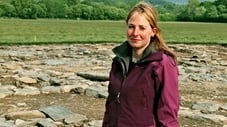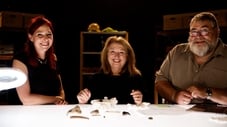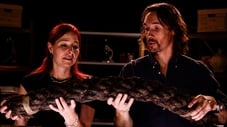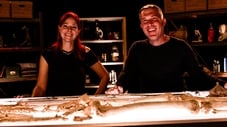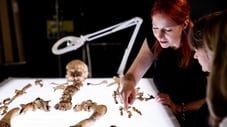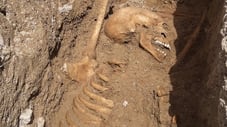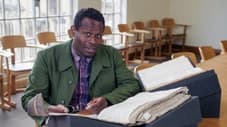Alice Roberts as Self - Presenter
Episodes 53
The Romans
Roman finds include the mystery of 97 babies murdered by the Thames, a fabulous Roman coin hoard found in Somerset and a man buried on a layer of dead animals.
Read MorePrehistory
Her journey takes her from Orkney to Devon by land, sea and air.
In Norfolk, flint tools unearthed this year push the earliest human occupation back by 200,000 years, to around one million years ago.
In Orkney an early farm yields glimpses of our ancestors' earliest religious beliefs and customs - cattle skulls buried within building walls, and tiny household goddesses.
In Devon, we find one of the oldest known shipwrecks. And a bronze age burial holds a mystery, and touching evidence of grief echoing down over 2000 years.
Read MoreAnglo-Saxons
The Anglo-Saxons - they divided our land and heralded the arrival of the Dark Ages. But were they really just barbarians?
Dr Alice Roberts continues her journey through a year of archaeology, visiting the key sites that are throwing light on this most mysterious of periods. She visits the royal seat of power at Bamburgh, Northumbria and sees how the skeletons tell tales of violent death, but also of tenderness.
Read MoreThe Tudors
Alice Roberts finds out about discoveries that shed new light on the Tudor Age, visiting excavations at Shakespeare's first theatre, in London's Shoreditch, and at his last home in Stratford-upon-Avon, where clues reveal his economical use of money. In Wales, she meets a team of archaeologists learning about the realities of Henry VIII's dissolution of the monasteries, while on the banks of the Thames, the history of a forgotten royal palace is uncovered
Read MoreAge of Bronze and Iron
Dr Alice Roberts discovers what kind of a place Britain was before the Romans invaded.
Read MoreIce and Stone
Dr Alice Roberts goes in search of our elusive Stone Age ancestors.
Read MoreEast
Professor Alice Roberts and archaeologist Matt Williams present 2014's most outstanding archaeology. In the summer, archaeologists have been unearthing our history in hundreds of digs across Britain. They have gone to extraordinary lengths to uncover long lost treasures - retelling our story in a way only archaeology can. With unique access to some of the country's best digs, our teams have been self-shooting their excavations to make sure the audience is there for every moment of discovery. In this episode, we're in the east of Britain, and the archaeologists join us back in the Norwich Castle Museum to look at the new finds and what they mean.
Read MoreWest
Professor Alice Roberts and archaeologist Matt Williams present 2014's most outstanding archaeology. In the summer, archaeologists have been unearthing our history in hundreds of digs across Britain. They have gone to extraordinary lengths to uncover long lost treasures - retelling our story in a way only archaeology can. With unique access to some of the country's best digs, our teams have been self-shooting their excavations to make sure the audience is there for every moment of discovery. In this episode, we're in the west of Britain, and the archaeologists join us back in the Dorset Country Museum to look at the new finds and what they mean
Read MoreNorth
Professor Alice Roberts and archaeologist Matt Williams present 2014's most outstanding archaeology from the north of Britain. Sitting in the heart of the Neolithic Orkney World Heritage Site, the Ness of Brodgar houses a 5,000-year-old temple at the heart of a sacred landscape, built out of stone over hundreds of years. We catch the unearthing of a Roman altar dedicated to Jupiter that was originally carved in the 2nd century, when Maryport was part of the coastal defences linked to Hadrian's Wall. 11,000 years ago Flixton in Yorkshire was an island used by our very earliest ancestors, and it has preserved vital clues about their world and the wild horses they hunted and ate. In Ardnamurchan, a 5,000-year-old cemetery - housing burials from the Bronze and Iron Ages... and an intact Viking boat burial. A Tudor-era aristocrat's feasting hall is revealed... and how one night the revelry came to a very abrupt end. One of the richest hoards of Pictish treasure ever found reveals the metalworking secrets of the mysterious tribes who ruled Dark Ages Scotland.
Read MoreDigging for Ireland
Professor Alice Roberts and archaeologist Matt Williams present the highlights from this year's archaeology in Ireland.
There is new evidence and a new theory to explain the amazing phenomenon of Ireland's perfectly preserved Iron Age bog bodies. Could these men really have been kings, murdered when their reigns failed?
A dig at the iconic Dunluce Castle opens up the controversial Plantation of Ulster.
A disagreement pits experts against local knowledge as the hunt is on for the location of the Battle of Ford of the Biscuits from the Elizabethan Nine Years' War - with unexpected results.
A burial ground yields clues to a Bronze Age invasion of Ireland, a period when it became known as Europe's Eldorado.
An astonishing lough yields perfectly preserved boats from Bronze, Iron and Viking Ages. The burial ground of the prison known as Ireland's Alcatraz offers up unexpected evidence of kindness among the inmates.
Plus amazing plunder from the Spanish Armada, from Viking raiders and from Ireland's age of heroes, all curated from the Ulster Museum in Belfast.
Read MoreNorth
Professor Alice Roberts explores the year's most exciting archaeological finds in the north of Britain. A team discovers clues to Scotland's first kingdoms, metal detectorists unearth a hoard of Viking treasure, and a new housing development reveals a graveyard of Iron Age warriors.
Read MoreWest
We discover the camp from which Vikings invaded Britain, and find groundbreaking new evidence that the world-famous Avebury stone circle isn't just a sacred site but a place where our ancestors lived and worked - a discovery that's also changing our understanding of neighbouring Stonehenge. In Staffordshire, the oldest Iron Age gold in Britain is unearthed - a set of beautiful gold torcs, mysteriously abandoned 2,500 years ago.
Read MoreEast
We unearth the biggest collection of Roman writing tablets in Britain, giving insight into what Roman London was really like. Off the coast of Kent, we dive into the English Channel to complete the biggest marine excavation since the Mary Rose - an 18th-century East India Company ship, packed with silver. Also in Kent, we're on the detective trail to find the very first evidence of Julius Caesar's invasion of Britain - an ancient fort scattered with human skulls and weapons.
Read MoreNorth
Alice discovers the well-preserved writing tablets, swords and domestic items left by Romans at Vindolanda during a time of British rebellion. On the Scottish island of Iona, there are traces of a long-lost monastery and pilgrimage site that was originally built by the legendary saint Columba, and has been compared to Jerusalem. In the east of Scotland, a weapons hoard belonging to a wealthy Bronze Age warrior is unearthed.
Read MoreThe Horsemen of Hadrian's Wall
In this special, Professor Alice Roberts reveals the forgotten story of the Roman Army's secret weapon in Britain - their cavalry. These fearsome horsemen were the key to defending Britain's most famous Roman monument fortification, Hadrian's Wall.
Alice sets off across Hadrian's Wall to investigate any evidence the Roman cavalry left behind, while a team of archaeologists and historical re-enactors attempt to re-stage a Roman cavalry tournament - a spectacle that no one has seen for over 1,600 years.
We follow the team's training as they prepare for the performance, and Alice joins them at a public display in Carlisle where 30 riders perform in front of a crowd of spectators.
To put the cavalry's story in context, the film also explores the latest archaeological digs happening across the UK, each of which is searching for new evidence of the Roman cavalry.
On her journey across Hadrian's Wall, Alice visits some of the most iconic sites associated with the Roman cavalry, including Chester's Roman fort, Vindolanda fort and museum and Hexham Abbey. Along the way she builds a picture of the horsemen's lives here on the northern frontier of the Roman Empire.
Read MoreNorth
Professor Alice Roberts celebrates the biggest and best archaeological discoveries of 2018 from the north of the UK. Each digging team has been filming its own excavations, giving us an unprecedented view of each excavation as it happens.
Alice begins the programme with a prehistoric Pompeii at the Black Loch of Myrton. Uncovering incredibly preserved 2500-year-old houses, archaeologists are stepping back in time and glimpsing what life was really like in an Iron Age village. We follow archaeologists uncovering a previously unknown Anglo-Saxon cemetery in Lincolnshire full of spectacular and unusual grave goods.
We go on the hunt for a lost Second World War reconnaissance Spitfire in Norway and piece together the story of its brave pilot.
Deep in the vaults at the National Museum of Scotland in Edinburgh, we explore one of its greatest treasures, the Westness Brooch. We also head to the island of Rousay in Orkney, where archaeologists rescue a Neolithic tomb before it gets washed away and discover an incredible trace of our ancestors on a rare Pictish stone.
In Salford, a major regeneration project is unearthing the largest jail in Georgian England and its radical approach to crime and punishment. Roving archaeologist, Raksha Dave gets privileged access behind the scenes in the conservation labs at Vindolanda Roman fort and discovers what really happens when the digging stops.
Read MoreWest
Professor Alice Robert explores this year’s most exciting archaeological finds from the west of Britain. Every new discovery was filmed by the archaeologists themselves giving us an unprecedented view of each excavation as it happens.
In this episode, we join a team as they undertake the largest maritime investigation since the Mary Rose and reveal the extraordinary story of HMS Invincible. At Silchester, archaeologists investigate a Bathhouse that reveals how the Romans stamped their mark on Britain. A buried military camp in Hampshire shows why German soldiers were key to our security in the 18th century and archaeologist Raksha Dave goes behind the scenes to tell the tragic tale of individuals from a 19th-century pauper’s graveyard.
Read MoreEast
Professor Alice Roberts explores this year’s most exciting archaeological finds from the East of Britain. Every new discovery was filmed by the archaeologists themselves giving us an unprecedented view of each excavation as it happens.
In this episode, we join a team in Suffolk as they uncover an ancient lost monument as old as Stonehenge. We travel a little further East than usual to a WWI battlefield in France to explore one of Britain’s earliest and most disastrous tank battles, and then return to Suffolk as archaeologists try to make sense of some disturbing Roman burial practices. Also, one lucky metal detectorist chances upon a coin hoard that gives us insight into the effect the English civil war had on the lives of ordinary people.
Our roving archaeologist, Raksha Dave goes behind the scenes at an archaeological lab in Brighton and follows an investigation into a lost
medieval village.
Read MoreIron Age Revealed
Alice Roberts follows the excavation of Iron Age Britain’s most spectacular grave. A team of archaeologists in East Yorkshire have uncovered the remains of only the third upright chariot burial ever found in Britain, and the only chariot burial ever found in this country with the chariot harnessed to two standing ponies. This sensational find is the lead dig for the Digging for Britain Iron Age special.
Read MoreWWII Special
The team are on an archaeological hunt of our more recent past as they follow the search for artefacts from World War II.
Read MoreThe Greatest Discoveries: Episode 1
Professor Alice Roberts re-examines key archaeological sites of prehistoric Britain, from the arrival of the earliest humans to mysterious ceremonies at Stonehenge.
Read MoreThe Greatest Discoveries: Episode 2
Professor Alice Roberts re-examines the key archaeological sites of Iron Age Britain, from an incredible chariot burial in Yorkshire to a vast coin hoard on Jersey.
Read MoreThe Greatest Discoveries: Episode 3
Professor Alice Roberts re-examines the key archaeological sites of Roman Britain, from the foundation of Londinium in the south to fierce siege battles in the north.
Read MoreThe Greatest Discoveries: Episode 4
Professor Alice Roberts re-examines the key archaeological sites of Anglo-Saxon Britain and finds the evidence of a warrior culture and the enormous wealth of their aristocracy.
Read MoreRoman Towns and Tudor Shipwrecks
Digs in southern England reveal a previously unknown Roman town, a Tudor ship buried beneath a quarry and evidence of Henry VIII’s financial under the Tower of London.
Read MoreArthur's Stone and a Georgian Mine
In the west of the UK, a spectacular monument older than Stonehenge, a 200-year-old mine trapped in time and a lost medieval friary.
Read MoreHeadless Romans and Anglo Saxon Gold
A gatehouse riddled with Civil War bullets, a unique Iron Age shield made from bark and Roman burials with pots where the heads should be.
Read MoreMystery Shipwreck and a Roman Army Camp
Alice Roberts reveals a Dutch ship sunk by the English, a Cornish Roman fort and a 5000-year-old Neolithic monument.
Read MoreRoman Mosaics and Ancient Weapons
Travelling east, Alice discovers a Roman barn conversion, unearths a Tudor fort and finds intricately carved 10,000-year-old weapons.
Read MoreIce Age Camp and a Saint with Syphilis
In Scotland and the north of England, Alice investigates an Ice Age camp, the mystery of a medieval skeleton and the earliest evidence of salt making in Britain.
Read MoreThe Roman Emperor’s Bathhouse
Digs in northern Britain reveal a Roman emperor’s lost bathhouse, the sunken treasures of medieval pilgrims and a formidable fortress perched on top of a Scottish mountain.
Read MoreAnglo-Saxon Gold and Rebellious Nuns
In central England, an RAF airbase with a Roman past, a forgotten medieval nunnery, a gold pendant from a 7th-century grave and a pub with a very long history of hospitality.
Read MoreA Norman Panic Room and a Mesolithic Fish Trap
In the west of Britain, there's a rare medieval cemetery, a disappearing Mesolithic landscape, a mysterious Iron Age burial and the ruins of a Gothic masterpiece.
Read MoreA Roman Mystery and Waterloo’s Disappearing Dead
Roberts reveals the most fascinating archaeological finds this year in the East of England: a Roman dodecahedron, the secrets of Boudicca’s hill fort and Waterloo’s disappearing dead.
Read More3000-Year-Old Shoes and Giant Axeheads
Archaeology in the south of England unearths Britain’s oldest shoe, the lost shipyard of one of England’s greatest warrior kings and Britain’s top-secret WWII defences.
Read MoreForgotten Fortresses and Lost Villages
Digs in the West of Britain reveal a forgotten fortress teetering on the edge of a cliff, evidence of the oldest house in Cardiff and a discovery at a Roman mosaic that shocks the experts.
Read MoreSaxon Gold and Buried Coins
The most incredible grave goods ever found on Digging for Britain, a strange Roman sarcophagus filled with plaster and an intriguing medieval coin hoard.
Read MoreDinosaur Highway and Roman Sauna
A quarryman makes the discovery of a set of very large footprints, and a chance find reveals a spectacular Roman villa with mosaics and a sauna
Read MoreIsland Treasures
Exploring Britain’s islands: a 5,000-year-old Neolithic tomb, an international effort to save a WWI warship, and a Neanderthal hunting ground off Jersey’s coast.
Read MoreRoman Crime and Ancient DNA
Gold is found at a bishop’s palace, a Roman crime is uncovered, detectorists unearth a staggering bronze age haul, and ancient DNA solves a medieval mystery
Read MoreChariots and Slaves
In the west of Britain, there's one of the largest Roman buildings ever discovered in Britain, an Iron Age chariot is saved, and evidence is found of the transatlantic slave trade in Devon.
Read MoreLost Mansions and Impaled Prisoners
Extraordinary digs from the south - a Romani encampment in the New Forest, a convict’s burial ground, discovery of a civil war mansion and London’s best-preserved Roman cemetery.
Read More



